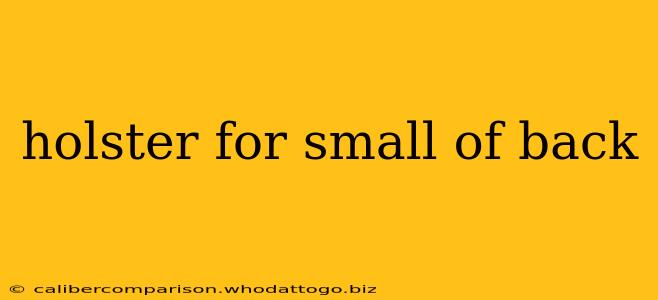Choosing the right holster is crucial for comfortable and safe concealed carry. For many, the small-of-back (SOB) position offers a unique blend of concealment and accessibility. However, it's a placement that requires careful consideration and the right equipment. This guide will explore everything you need to know about SOB holsters, helping you make an informed decision based on your needs and preferences.
Understanding the Advantages and Disadvantages of SOB Holsters
The small-of-back holster placement offers several advantages:
- Excellent Concealment: The position naturally conceals a firearm beneath clothing, especially with jackets or coats. This makes it a popular choice for individuals prioritizing discretion.
- Accessibility: With the right draw technique, the firearm can be accessed relatively quickly.
However, there are also significant drawbacks to consider:
- Increased Risk of Accidental Discharge: The proximity to the body and potential for clothing snags increases the risk of accidental discharge. This risk necessitates meticulous training and a high level of firearm safety awareness.
- Limited Comfort: Certain designs and firearm sizes can be uncomfortable, especially during prolonged periods of wear. Finding a holster that fits both your body and firearm is paramount.
- Difficulty with Drawing: The draw stroke from an SOB holster is inherently more complex and requires significant practice to master safely and efficiently. Improper technique can lead to injury or ineffective weapon deployment.
- Potential for Back Injury: The weight of the firearm can cause strain and discomfort, particularly during prolonged sitting or movement. Choosing a lightweight holster and practicing proper posture can mitigate this risk.
Choosing the Right Small-of-Back Holster: Key Factors
Selecting the appropriate SOB holster involves several critical considerations:
1. Holster Material and Design:
- Kydex: Known for its durability, rigidity, and resistance to moisture. Kydex holsters offer excellent retention.
- Leather: Offers a more comfortable carry, but may require more frequent cleaning and maintenance. Leather holsters generally offer less retention than Kydex.
- Hybrid Holsters: Combine the benefits of both materials—offering a balance of comfort and retention.
The design should prioritize firearm retention to minimize the risk of accidental loss or shifting during movement.
2. Retention Mechanisms:
Several retention mechanisms are available, each offering different levels of security:
- Friction Retention: Relies on the friction between the holster and the firearm. Simpler, but offers less security.
- Snap Retention: Includes a snap or button to secure the firearm. Provides added security compared to friction retention.
- Passive Retention: This type uses minimal retention mechanisms, focusing on the holster's shape and material to secure the firearm. Offers the quickest draw.
3. Comfort and Fit:
The holster should be comfortable enough for extended wear without causing discomfort or chafing. Consider factors like:
- Holster Shape: A well-designed holster will conform to the natural curves of the body.
- Belt Attachment: A secure and sturdy belt attachment is crucial for stability and preventing the holster from shifting.
- Adjustability: Some holsters offer adjustable features, such as cant (angle) adjustment, allowing for a personalized fit.
4. Firearm Compatibility:
It is crucial to select a holster specifically designed for your firearm model. Using an incompatible holster can significantly reduce retention and increase safety risks.
Safety Precautions When Using an SOB Holster
Using an SOB holster demands meticulous attention to safety:
- Extensive Training: Professional firearm training is essential to master the proper draw technique and ensure safe handling.
- Regular Practice: Regular dry-fire practice (with an unloaded firearm) helps to reinforce safe draw techniques and build muscle memory.
- Awareness of Surroundings: Be mindful of your surroundings and potential obstacles that could interfere with your draw.
- Clothing Considerations: Choose clothing that allows for a smooth and unobstructed draw.
Conclusion
While small-of-back holsters offer a degree of concealment, the inherent risks associated with this placement necessitate careful consideration and responsible gun ownership. Thorough research, professional training, and a commitment to firearm safety are paramount when choosing and using an SOB holster. Remember to always prioritize safety and practice responsible gun handling.

